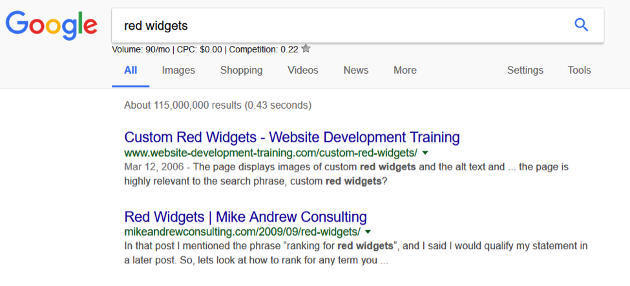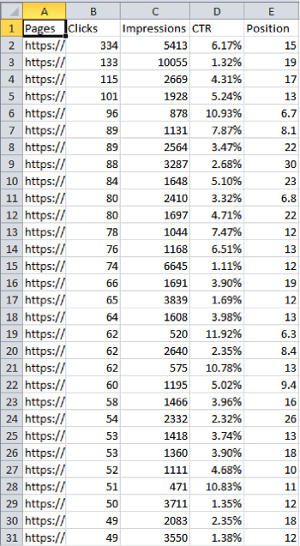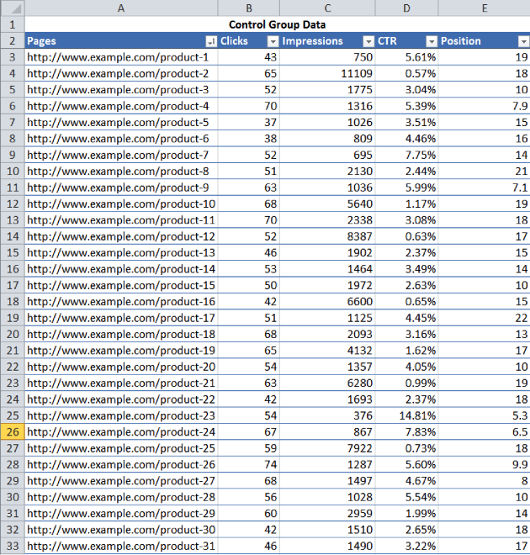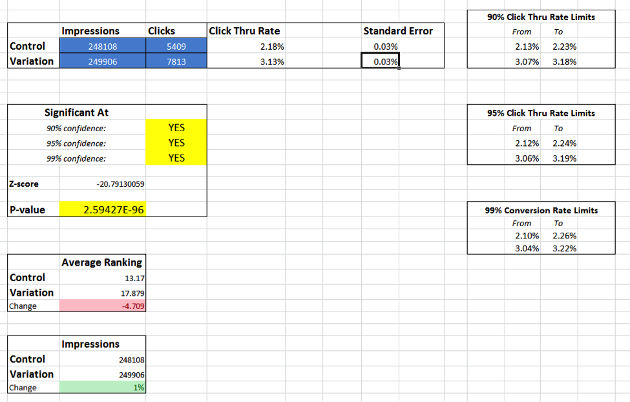SEO has one fundamental objective: Drive organic traffic to your site. That is generally done by accomplishing one fundamental goal: Increase organic rankings in search engines.
However, what if there were a way to improve your traffic without having to worry about your rankings? What if you could improve traffic even if your rankings don't change?
You can! By applying creative optimization of your title tags and meta descriptions, you can improve your clickthrough rate, which can directly affect the amount of organic traffic you get from search engines without changing your rankings at all.
What does all that mean? We'll start with a bit of backstory.
Conversion Rate Optimization: A Very Brief Summary
The practice of conversion rate optimization (CRO) is a field of study in its own right, and I won't profess to be an expert. However, the concept of CRO will inform our CTR tests, so I will provide a brief outline.
What is conversion rate?
Regarding Web traffic, the "conversion rate" is determined by the amount of visitors who take the action you want them to take, divided by the total amount of visitors to your webpage.
So if you have 1,000 visitors, and 50 of them take the desired action (form submission, phone call, product purchase, etc.), then your conversion rate would be as follows: 50 / 1,000 = .05 = 5% conversion rate.
CRO works to improve that rate by modifying the design of a webpage. That is often done by a split-test, AKA "A/B-test": A certain portion of traffic is shown the original design (version A, or control), while the remainder is shown another design (version B, or variant).
By comparing the conversion rates of the two segments, you can determine whether version B resulted in a positive change, a negative change, or neither.
For you to derive any valid conclusions, the differences need to be statistically significant (i.e., not the result of random chance).
CRO on Google Search Results
How does that translate to CTR experiments? Simple: treat the clickthrough rate exactly as you would a conversion rate.
Let's take the previous example: If you have 1,000 impressions on a Google search results page, and you get 50 clicks on your results, your CTR would be as follows: 50 / 1,000 = .05 = 5% clickthrough rate.
When viewing CTR and conversion rate as similar formulas, you practice the principles of CRO directly on Google's search results page.
You do that by modifying what you have control over—the title tags and meta description of your pages:

By modifying those two elements, you can test how they affect CTR, just as you would test different design elements with CRO experiments.
Things to Keep in Mind
- Title tags are a big ranking factor! That means any changes to title tags can (and likely will) have some effect on your organic rankings. You can monitor that as part of your experiment, but be prepared.
- Meta descriptions are not a ranking factor, so no worries about modifying them.
- Yes, Google will rewrite your title tags or meta descriptions on occasion. Don't let that dissuade you from testing. The data will factor in these changes, so it will still provide valid comparisons.
Before you hop into these tests, you need to grab some data. How do you do that? Google Search Console!
CTR Data From Google Search Console
You can access the Google SERP data via the Google Search Console.
In the left-hand navigation, go to Search Traffic > Search Analytics. You'll see a screen similar to this one:

In Search Analytics, select the following options:
- "Pages": You are going to be running page-specific experiments, so looking at query data won't help.
- All metrics: Your want to include clicks, impressions, CTR, and position.
- Date range: Setting the date range to 30 days might be fine if you've got lots of traffic, but the more data, the better, so you might want to consider 90 days.
Find the "Download" button (at the top-right), and export a spreadsheet. You'll have a file that looks something like this:

The file will be a maximum of 1,000 pages (that's all that Google Webmaster Tools/Search Console provides).
Picking a Test Set
If you have plenty of data to work with, you don't need to test every URL. If you are working with a smaller site, it's OK to use more or all of your URLs in a test; just make sure you have plenty of historical data to compare with.
I like to pick the top 100 for the test set. That offers two distinct advantages:
- Lots of impressions, which makes it easier to make statistical inferences
- High probability that Google Search Console will have data for the selected URLs in the next month (not always guaranteed as a result of data limitations)
Copy and paste the top 100 pages (or whatever your test set is going to be) into the "Control Group Data" worksheet of your example spreadsheet.

What Now? Picking a Test Variable
At this point you've collected your historical data, which you'll compare against your test. Now would be a good time to talk about exactly what you are going to test.
There are several options...
1. 'Sales' Copy in the Meta Description
- New trigger words
- Shorter copy
- Longer copy
- Value proposition changes
- Special offers, discounts, CTAs
- Name-dropping (to build credibility)
2. Removal of the Meta Description Altogether
Yes, this sounds counterintuitive, but you never know!
3. Formatting of the Title Tag
- Brand name inclusion (at end, at beginning, not at all)
- Action words ("find," "browse," "buy," etc.)
- Shorter length, more concise
- Longer length, more descriptive
4. Emojis and Other Callouts
Google is now showing emojis in title tags, which means you can test callouts. Some popular emojis include a trophy, a thumbs up, and a finger pointed right.
You can visit EmojiCopy.com to browse through the available Unicode emojis and copy/paste.
Some Testing Considerations
In your testing, think deeply about potential test variables. The best tests come down to gaining insight into your target audience (such as emotional trigger words). Other tests, such as emojis, are a little more gimmicky but can still be effective.
If you are struggling to come up with tests, just lock yourself in a room and don't let yourself out until you've thought of at least five unique tests. You'll have a breakthrough eventually—trust me.
Running the Test
Now that you've collected historical data and established a test variable, the next step is to actually run the experiment!
Here are some important steps:
- Once you push a variable live, you should manually inspect (or use a tool such as Screaming Frog) to ensure that the test variables are actually live.
- The variables need to be indexed first before you can start collecting data to analyze. Just because you've made changes to your title tags doesn't mean Google is showing them to users yet.
- Re-indexing can take two weeks or more, depending on your site. To speed up the process, you can...
- Manually submit your changes via the URL submit tool in Google Webmaster Tools.
- Create a unique XML sitemap and submit it via Google Webmaster Tools.
- If you've done either of those steps, come back in a few days and check manually (which means Googling your URLs to see whether the new data is showing) to see whether Google index has updated.
- Once you've confirmed that it has, make note of the date. That is the point at which you can start collecting data.
Done all that? Now it's the waiting game. I like to give my tests at least one month of being live and indexed before analyzing any results.
Analyzing the Results
Head back over to the Google Search Console and export the recent top 1,000 pages, making sure that your date range includes only data from after your pages were re-indexed by Google.
You'll want to dump the list into a spreadsheet so you can extract only your test set (top 100, etc.).
(This is relatively straightforward if you use Excel regularly, but if you don't, there are plenty of handy VLOOKUP tutorials online, so I will skip the step-by-step instructions.)
Take the new test set data and copy/paste it into the "Variant Group Data" worksheet of your example spreadsheet.
Now you have your control data and your variant group data ready to be analyzed. Through the magic of Excel formulas, all the analysis is done automatically in our "statistical significance worksheet"!
By inputting our example test data, we see the following output:

As you can see, we are statistically significant at all three confidence levels, which means less than 1% of our results happened purely by chance.
Ruling Out Rank Changes
At this point, you want to rule out rank increases as a cause for an increased CTR. Obviously, if something ranks higher, it will get a much higher CTR regardless of title tag or meta description.
Whenever you deal with title tag changes, rank fluctuations are very possible. You should not only compare data after the fact (this is already pulled together in the spreadsheet) but also track your keyword rankings in real time to check for fluctuations.
In the above example, although our average ranking did drop, impressions improved 1%. That means that a few outlier ranking drops are likely the cause of the observed ranking decline, but it's not actually affecting SEO visibility.
* * *
Winning at SEO and digital marketing is all about how much you push to be ahead of the curve. Although studying industry research and following best-practices can help, the real gold is found through testing new approaches.
For large-scale sites that have thousands of pages, CTR experiments can provide ways to get "more juice" from your current organic rankings, as well as provide insight into the users' mindsets and/or pain points.




